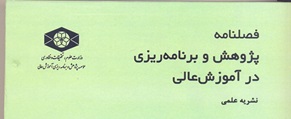شناخت بهره وری تحقیقات و فرهنگ سازمانی حاکم بر آن؛ مطالعه موردی :یکی از دانشگاههای مستقر در تهران
نویسندگان
1 عضو هیأت علمی دانشگاه شهید ستاری
2 عضو هیأت علمی دانشگاه تربیت معلم
چکیده
هدف از پژوهش حاضر بررسی و شناسایـی بهره وری تحقیقات و فرهنگ سازمانی حاکم برآن در یکی از دانشـگاههای مستقر در تهران و ارائه راهکارها و مدل مرتبط با مدیریت فرهنگ سازمانی به منظور رفع مشکلات و تنگناها و بهبود و توسعه تحقیقات در این دانشگاه است. با توجه به ماهیت، اهداف و سؤالات ویژه تحقیق، از روش تحقیق مطالعه موردی استفاده شد. جامعه آماری تحقیق 165 نفر اعضای هیئت علمی محقق (استادیار به بالا) بود که در سال 82-1381 به امر پژوهش و آموزش اشتغال داشتند. از میان این جامعه، تعداد 115 نفر به روش نمونه گیری تصادفی طبقه ای انتخاب شدند. ابزار گردآوری اطلاعات شامل شاخصهای بهره وری تحقیقات و یک پرسشنامه فرهنگ سازمانی است. برای تجزیه و تحلیل دادههای آماری شاخصهای بهره وری تحقیقات که غالباً به صورت درصد، نسبت و نرخ رشد است، از میانگین هندسی و برای تحلیل داده های فرهنگ سازمانی که در مقیاس فاصله ای به دست آمد، از آمار استنباطی آزمون معنی داری t برای محاسبه تفاوت میانگینها در دو جامعه همگون (وابسته) با درجه آزادی 99= df و سطح معنی داری 05/ 0= استفاده شد. نتایج پژوهش بیانگر آن است که شاخصهای بهره وری تحقیقات در دانشگاه مورد مطالعه شامل بهره وری پژوهشگران، بهره وری علمی (تولید دانش ) و بهرهوری اعتبارات پژوهشی چندان مطلوب نیست. میانگین عددی شاخصهای دهگانه فرهنگ سازمانی مشتمل برخلاقیت، ریسک پذیری، سبک رهبری، حمایت مدیریت، یکپارچگی و هماهنگی، کنترل، هویت سازمانی، نظام پاداشها، سازش با پدیده تعارض و الگوی ارتباطات در مقیاس لیکرت کمتر از 3 و مبیّن فرهنگ سازمانی ضعیف حاکم بر تحقیقات این دانشگاه است. همچنین، فرهنگ سازمانی تحقیقات در وضعیت موجود هر یک از دانشکده های علوم تربیتی و روانشناسی، شیمی، علوم پایه، تربیت بدنی، ادبیات و علوم انسانی، ریاضی و کامپیوتر با فرهنگ سازمانی در وضعیت مطلوب در همان دانشکده ها متفاوت و این تفاوت معنی دار است. این امر حکایت از شکاف و فاصله میان فرهنگ سازمانی موجود و فرهنگ سازمانی مطلوب تحقیقات دانشگاه دارد. ضمن اینکه بین نظرهای اعضای هیئت علمی (استادیار به بالا) دانشکده ها درخصوص معنی داری شاخصهای فرهنگ سازمانی در دو وضعیت موجود و مطلوب تحقیقات، همپوشی و همبستگی مثبت وجود داشته است.
کلیدواژهها
عنوان مقاله [English]
Research Productivity Recognition and Dominant Organizational Culture: A Case Study of One of Universities in Tehran
نویسندگان [English]
- Ahmad Reza Sanjary 1
- Mohammad Reza Behrangi 2
1 Faculty Member of Shaheed Satary University
2 Faculty Member of Tarbiat Moalem University
چکیده [English]
The purpose of this research is to examine and identify the trend of research productivity and dominant organizational culture in one of Universities in Tehran and to present guidelines and a model related to management of organizational culture in order to remove problems and bottlenecks and promote and develope the research in this university.
Regarding to essence, objectives and special research questions, a case study method was used. Statistical population includes 165 faculty members (assistant professors and higher). By using stratified sampling data, 115 subjects were randomly selected.
Data collection instrument includes research productivity indicators and an organizational culture questionnaire.
In order to analyze the statistical data of research productivity indicators which are mostly as percentage rate, ratios and growth rates, geometrical mean was applied and for analyzing organizational culture data which was achieved in interval scales, the inferential statistics of –test was used for calculating means differentiation in two similar (dependent) populations (with df=99, alpha – 0.05).
The results represented that general trend of research productivity indicators of the university containing the productivity of researchers, scientific productivity (knowledge production) and productivity of research budget were negative.
Numerical mean of ten organizational culture indicators containing creativity, risk taking, leadership style, management support, consistency and coordination, control, organizational identity, reward system, compromise with conflict phenomenon and communication model is less than 3 in Likert Scales which represented weak organizational culture. In addition, organizational culture of research in College of Education and Psychology, Chemistry, Basic Sciences, Physical – Education, Literature and Humanities, Mathematics and Computer differ significantly from their desired situations.
Besides, there were positive correlations between faculty-members, of view about significance of organizational culture indicators in both current and desired research situations. This represents the gap between current and desired organizational culture of university research.
کلیدواژهها [English]
- productivity
- Trend Rate
- Research
- Organizational Culture and University
 فصلنامه پژوهش و برنامه ریزی در آموزش عالی
فصلنامه پژوهش و برنامه ریزی در آموزش عالی
